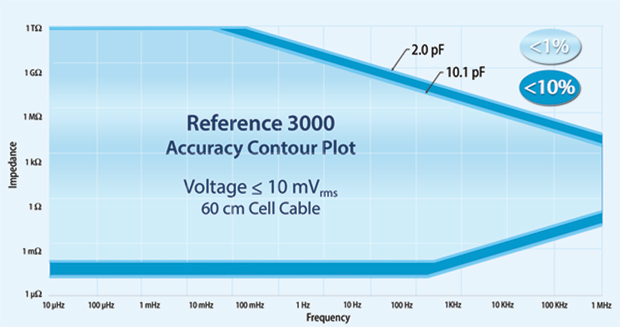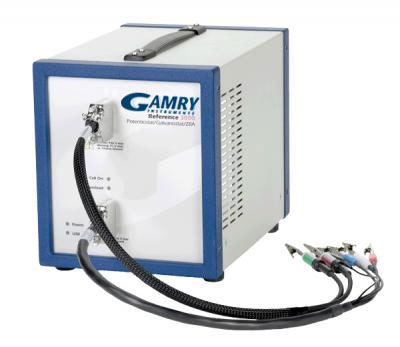Description
The Reference 3000™ is a high-performance potentiostat/galvanostat/ZRA recommended for battery, capacitor, or fuel cell development, as well as general electrochemical measurements requiring higher currents.
Key features include:
- High-current, high-performance for researchers studying batteries
- Maximum Applied Potential – Up to +/-32V@+/-1.5A or +/-15V@+/-3A
- EIS – 10 μHz – 1 MHz
For techniques including:
- Physical Electrochemistry
- Pulse Voltammetry
- DC Corrosion
System Highlights
Overview
The Reference 3000 is a high-current, high-performance potentiostat well suited for researchers studying batteries, fuel cells or supercapacitors. It is also well suited for general physical electrochemistry experiments requiring high voltages and high currents. For very high current applications, the Reference 3000 can be interfaced with our Reference 30K Booster.
Electrochemical Impedance Spectroscopy
The Reference 3000 is fully equipped to perform electrochemical impedance spectroscopy up to 1 MHz. The Accuracy Contour Plot below provides a detailed look at the performance you can expect from your instrument in real-world situations. The results include the cell cable.

Options
Auxiliary Electrometer
The auxiliary electrometer is a factory installed option that adds an array of eight differential voltage inputs. Each of the eight channels can measure a ± 5 volt signal anywhere over the Reference 3000’s entire compliance voltage range. Impedance measurements up to 100 kHz can also be performed using the auxiliary electrometer.
Extended Cable Lengths
Extended length cell cables (1.5 and 3 meter) are also available for your convenience.
Auxiliary Electrometer Cables: The standard Auxiliary Electrometer cables are 90 cm. Extended length cables (1.5 and 3 meter) are available.
More details
Below are additional details regarding the capabilities of the Reference 3000 potentiostat. Each bullet point contains a list of the type of techniques available for the instrument to run.
- Physical Electrochemistry – Techniques such as cyclic voltammetry, chronoamperometry, and chronopotentiometry and derivatives of these techniques.
- Pulse Voltammetry – Techniques such as pulse voltammetry, square wave voltammetry, and associated stripping techniques such as anodic stripping voltammetry.
- DC Corrosion – Run standard DC corrosion tests such as polarization resistance, potentiodynamic, cyclic polarization, and galvanic corrosion in addition to a number of others.
- Electrochemical Energy – Test single-cells and stacks of various batteries, fuel cells or supercapacitors. Includes charge, discharge, cyclic charge-discharge techniques, potentiostatic, galvanostatic, self-discharge, leakage rate, and read cell voltage.
- Electrochemical Signal Analyzer – Designed specifically for the acquisition and analysis of time-dependent electrochemical noise signals. Cell voltage and current are continuously monitored at rates from 0.1 Hz to 1 kHz. A full featured set of analysis tools provides powerful analysis features such as statistical analysis, detrending, impedance spectra, and histogram analysis.
- Electrochemical Frequency Modulation – A non-destructive corrosion rate measurement technique. It allows for measurement of the corrosion rate without prior knowledge of the Tafel constants. In addition, the technique determines the Tafel constants and provides 2 internal validity checks.
- Critical Pitting Temperature – controls a Gamry Potentiostat, TDC4 Temperature Controller, and associated accessories to automatically measure the Critical Pitting Temperature of a material.
- Electrochemical Noise – A more general form of electrochemical noise testing. It is also an ECM8 Multiplexer compatible electrochemical noise software package.
- Electrochemical Impedance Spectroscopy – includes experimental scripts for potentiostatic, galvanostatic and hybrid impedance spectroscopy experiments in addition to single frequency techniques like Mott-Schottky. We also have our unique power-leveling multisine technique that improves signal-to-noise across the spectrum. On the analysis side, it provides tools for fitting spectra to equivalent circuit models, Kramers-Kronig transform for data validation and a graphical model editor. Our software even includes a script for EIS simulation.
- eChemDC Toolkit – contains all of the capabilities of the eChemBasic and further extends these capabilities by adding advanced signals and data acquisition modes to simplify implementing experiments like cyclic voltammetry, pulse voltammetry, and dynamic DC corrosion techniques. Also includes more advanced stop tests, particularly useful in fast experiments.
- eChemAC – Includes full capabilities of eChemDC Toolkit plus allows electrochemical impedance spectroscopy (EIS) and EFM experiments.
Other features
- 2, 3, and 4 electrode measurements
- Electrical Isolation
- Floating instrument: use with autoclaves, mechanical stress apparatus, or pipeline probes.
- Built-In EIS
- On-board DDS to perform EIS from 10 µHz to 1 MHz.
- DSP (Digital Signal Processing) Mode
- Oversamples for improved signal-to-noise and accurate capacitance measurements.
- Current Interrupt and Positive Feedback iR Compensation
- Gamry potentiostats and their controlling software use control loop algorithms to accurately measure and correct for uncompensated resistance.
- Auxiliary I/O
- Control additional equipment via additional I/O interfaces: external signal input, analog voltage output, analog current output, auxiliary A/D input, and digital I/O connector.
- Warranty
- Protected by 2-year factory service warranty.
Manuals
Reference 3000 Part #992-00120
Specifications
SYSTEM |
|
| Potentiostat | Yes |
| Galvanostat | Yes |
| Zero Resistance Ammeter | Yes |
| Floating (Isolated from Earth Ground) | Yes |
| Cell Connections | 2, 3, 4 5 or 21+ |
| Maximum Current | ±3 A or ±1.5 A @ 32V |
| Current Ranges | 11 (300 pA – 3 A) |
| Current Ranges (including internal gain) |
13 |
| Minimum Current Resolution | 92 aA |
| Maximum Applied Potential | ±32 V |
| Rise Time | <250 ns |
| Minimum Time Base | 3.333 μs |
| Noise and Ripple (typical) | <2 μV rms |
| Weight | 7 kg |
| Dimensions | 20 (W) x 23 (H) x 30 (D) cm |
CONTROL AMPLIFIER |
|
| Compliance Voltage | ±32 V |
| Output Current | >±3 A |
| Speed Settings | 5 |
| Unity Gain Bandwidth | 1100, 330, 50, 5.0, 0.5 kHz |
EIS MEASUREMENT |
|
| EIS | 10 μHz – 1 MHz |
| EIS Accuracy | See Accuracy Contour Plot |
| Voltage AC Amplitude | 3 V maximum |
| Current AC Amplitude | 3 A maximum |
ELECTROMETER |
|
| Input Impedance | >1014 Ω || <0.2 pF |
| Input Current (typical) | <6 pA |
| Bandwidth | >15 MHz at – 3 dB |
| CMRR | >80 dB (100 kHz) >60 dB (1 MHz) |
POTENTIAL |
|
| Applied Accuracy | ±1 mV ±0.2% of setting |
| Applied Resolution | 12.5 μV, 50 μV, 200 μV/bit |
| Measured Accuracy | ±1 mV ±0.2% of reading |
| Measured Resolution | High-Resolution Electrometer: 400 μV, 100 μV, 10 μV, 1 μV/bit High Voltage Electrometer: 1.6 mV, 400 μV, 40 μV, 4 μV/bit |
CURRENT |
|
| Applied/Measured Accuracy | ±5 pA ± 0.05% of range ±0.2% of value (3 A – 3 nA) or 0.5% of value (300 pA) |
| Applied/Measured Resolution | 0.0033% full-scale/bit |
| Bandwidth | >10 MHz (3 A – 3 mA) >0.15 MHz (30 μA) |

